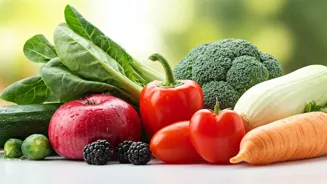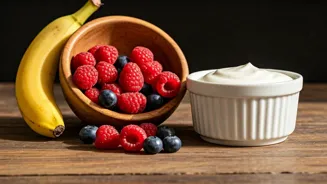Cruciferous Vegetables
Cruciferous vegetables such as broccoli, cauliflower, and cabbage are packed with healthy nutrients. However, they also contain a complex sugar called
raffinose. Humans lack the enzyme needed to break down raffinose efficiently. As a result, the undigested sugars pass through the small intestine and into the large intestine. Here, gut bacteria work to ferment them, producing gas, and consequently, bloating. Cooking these vegetables can sometimes help break down some of the complex sugars, making them easier to digest. Therefore, while healthy, one should be mindful of their portion sizes and how one's body responds to these vegetables, especially when eaten in the evening. The fiber content, though beneficial overall, can also exacerbate bloating symptoms in sensitive individuals, adding to the challenge.
Carbonated Beverages
Carbonated drinks, be it fizzy sodas or sparkling water, are notorious for contributing to bloating. These beverages are infused with carbon dioxide, which is a gas. When you consume these drinks, you're essentially introducing gas directly into your digestive system. This gas can accumulate in the stomach and intestines, leading to a feeling of fullness, pressure, and, of course, bloating. The bubbles in these drinks also encourage you to swallow more air, which adds to the gas build-up. Opting for still water or herbal teas can be a simple switch to significantly reduce bloating. Another factor is that carbonated drinks may contain artificial sweeteners like sorbitol, which can ferment in the gut and cause more gas. It’s wise to evaluate your drink choices for a less distended abdomen.
Dairy Products
Lactose intolerance is a common issue, where the body struggles to digest lactose, the sugar found in dairy products. When lactose isn't properly digested, it ferments in the gut, leading to gas production, bloating, and abdominal discomfort. For those who are lactose intolerant, consuming dairy products like milk, cheese, and yogurt can trigger these symptoms. The severity of the reaction varies from person to person. Individuals with mild lactose intolerance may be able to tolerate small amounts of dairy, while others might need to avoid it completely. There are also lactose-free alternatives available, such as lactose-free milk and yogurt, that can be incorporated into the diet without causing bloating. Paying attention to your body’s response to dairy is key to managing and reducing bloating.
High-Sodium Foods
Consuming foods high in sodium can lead to water retention in the body, which often manifests as bloating. Sodium helps to regulate fluid balance. When you consume excessive amounts, your body retains more water to dilute the sodium, leading to that puffy, uncomfortable feeling. Many processed foods, fast foods, and salty snacks are loaded with sodium. Even seemingly healthy options like certain canned soups and sauces can be surprisingly high in sodium. This retained water can cause the abdomen to feel swollen and distended. Being mindful of your sodium intake, especially during dinner, can help minimize bloating. Choosing fresh, unprocessed foods and checking food labels for sodium content can be effective steps. Cooking at home allows you to control the sodium levels in your meals, making it simpler to manage your fluid balance and reduce bloating.
Legumes And Beans
Legumes and beans, including lentils, chickpeas, and kidney beans, are great sources of fiber and protein, but they also contain complex sugars called oligosaccharides. Humans can't fully digest these sugars, resulting in fermentation by gut bacteria. This fermentation generates gas, which in turn causes bloating, abdominal cramping, and flatulence. Soaking beans before cooking can help reduce the oligosaccharide content, making them easier to digest. Eating smaller portions of these foods may also minimize symptoms. Additionally, gradually increasing your intake of legumes can help your body adjust to the fiber, potentially reducing bloating over time. Be mindful of your individual tolerance, as some people may experience more bloating than others from consuming these nutrient-rich foods.
Artificial Sweeteners
Artificial sweeteners, often used in sugar-free products to reduce calories, can be a hidden source of bloating. Many of these sweeteners, like sorbitol and mannitol, are poorly absorbed in the small intestine. Because they are not fully digested, they travel to the large intestine, where they are fermented by gut bacteria. This process creates gas, which leads to bloating, cramps, and even diarrhea in some individuals. These sweeteners are commonly found in diet sodas, chewing gum, and various packaged foods. Checking food labels is key to identifying and avoiding products that contain these ingredients. Being aware of how your body responds to these sweeteners can help you make informed choices. You could consider natural alternatives, such as stevia or erythritol, which may be better tolerated by some people, though individual responses will vary.
Processed Foods
Processed foods often contain a combination of ingredients that can trigger bloating. These items, such as ready meals, packaged snacks, and fast food, can be high in sodium, unhealthy fats, and artificial additives. The high sodium content contributes to water retention, leading to bloating. The unhealthy fats can slow down digestion, further exacerbating discomfort. Many processed foods also contain artificial ingredients like emulsifiers and preservatives, which can upset the gut microbiome and contribute to bloating. Reading food labels and being mindful of the ingredients in your meals is vital when dealing with this problem. Prioritizing fresh, whole foods while reducing your intake of processed options is a key step in preventing bloating. Home cooking allows you to control what goes into your meals, making it easier to avoid ingredients that might trigger digestive problems.


